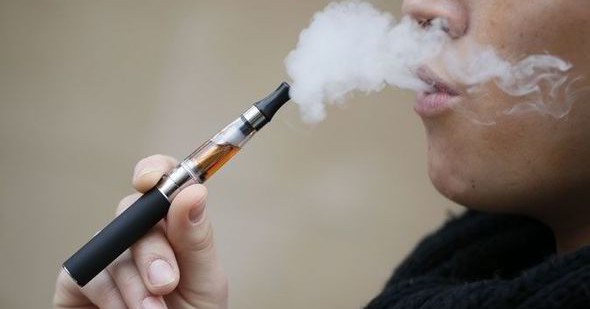
E-cigarette vapor can contain cancer-causing formaldehyde at levels up to 15 times higher than regular cigarettes, a new study reveals.
Researchers found that e-cigarettes operated at high voltages produce vapor with large amounts of formaldehyde-containing chemical compounds. This could pose a risk to users who increase the voltage on their e-cigarette to increase the delivery of vaporized nicotine, said the authors.
The study, published Jan. 22 in the New England Journal of Medicine, is the latest contribution to a debate on the safety of e-cigarettes that has so far has yielded little long-term data, though mounting evidence suggests there may be more risks than we initially thought.
“I think this is just one more piece of evidence amid a number of pieces of evidence that e-cigarettes are not absolutely safe,” lead researcher Dr. David Peyton, a chemistry professor at Portland State University, told NPR.
Health experts have long known that formaldehyde and other toxic chemicals are present in cigarette smoke. Initially, e-cigarettes were hoped to be without such dangers because they lack fire to cause combustion and release toxic chemicals.
But newer versions of e-cigarettes can operate at very high temperatures, and that heat dramatically amps up the creation of formaldehyde-releasing compounds, the study found.
“The new adjustable ‘tank system’ e-cigarettes allow users to really turn up the heat and deliver high amounts of vapor, or e-cigarette smoke,” Dr. Peyton said in a news release. Users open up the devices, put their own fluid in and adjust the operating temperature as they like, allowing them to greatly alter the vapor generated by the e-cigarette.
Dr. Peyton and his colleagues tested a commercially available vaporizer that allows consumers to adjust the voltage from 3.3V to 5.0V, using an artificial apparatus in the lab to simulate vaping. They were then able to collect the aerosol particles (vapor) in a tube to perform a detailed chemical analysis.
When used at low voltage, e-cigarettes did not appear to create any formaldehyde-releasing agents, the researchers found. However, vaping at high-voltage produced formaldehyde-releasing compounds known as hemiacetals, a dangerous a form of the chemical that the researchers say could increase the likelihood it will get deposited in the lungs.
What’s more, the researchers didn’t just discover traces of the chemical: “We detected a boatload of it,” Dr. Peyton told Oregon Live.
Formaldehyde is a known human carcinogen, according to the U.S. National Cancer Institute. The colorless, strong-smelling gas is most commonly used in glues for products such as particle board, and in mortuaries as an embalming fluid.
Based on the levels of hemiacetals in e-cigarette vapor, the researchers concluded that the life-time risk of developing formaldehyde-related cancer could be up to fifteen times greater for users of e-cigarettes than for users of traditional cigarettes.
Industry groups, not surprisingly, were quick to dismiss the findings. The American Vaping Association, a group advocating for e-cigarette makers, argued that the new study was flawed because e-cigarette users wouldn’t operate their devices at such high voltage.
“They use the device in a manner that no one does,” association President Gregory Conley told the Associated Press. Using the device at such as a high voltage for as long as the researchers did in the study “creates a burning, acrid taste” called a “dry puff” that would be unpleasant to users, Conley said.
But Dr. Peyton worries that these industry groups may be misrepresenting how their products are used, saying he and other researchers believe that people are using the devices on high settings.
“As I walk around town and look at people using these electronic cigarette devices it’s not difficult to tell what sort of setting they’re using, You can see how much of the aerosol they’re blowing out. It’s not small amounts,” Dr. Peyton told NPR. “It’s pretty clear to me that at least some of the users are using the high levels.”
And he’s not alone in his concern. In December 2014, researchers in Japan reported similar results, with their analysis finding up to 10 times the level of formaldehyde in e-cigarettes as regular ones. The findings prompted the Japanese government to begin an evaluation of whether e-cigarette sales should be regulated or banned.
“The most important finding is that the vapor contained recognized carcinogens,” Japanese health ministry anti-tobacco adviser Hiroyuki Noda told the Guardian. “Our panel of experts will now look into what possible effects those substances could have on the health of e-cigarette users.”
Other studies have found that secondhand smoke from e-cigarettes may contain higher levels of certain toxic metals than secondhand smoke from traditional cigarettes, even though overall exposure to harmful chemicals was lower.
Even more alarming, a study published just last month found that e-cigarette use can damage healthy lung cells and increase the risk of respiratory infection.
Noting that e-cigarettes remain unregulated, Dr. Peyton said these findings highlight the need for more oversight by the U.S. Food and Drug Administration. “We don’t know the health effects of this,” said Peyton. “It could be benign. Or it may be quite dangerous.”
In April 2014, the FDA proposed federal restrictions that would bring e-cigarettes under the same regulation as tobacco. The proposed federal restrictions are still under review and no schedule has been set for adoption.
While the researchers acknowledge that it’s too early to say for sure what the health effects of e-cigarettes are, they caution against assuming the devices are safe.
“A lot of people make the assumption that e-cigarettes are safe and they are perfectly fine after using for a year,” said co-author James F. Pankow, professor of chemistry and engineering at Portland State University. “The hazards of e-cigarettes, if there are any, will be seen 10 to 15 years from now when they start to appear in chronic users.”
